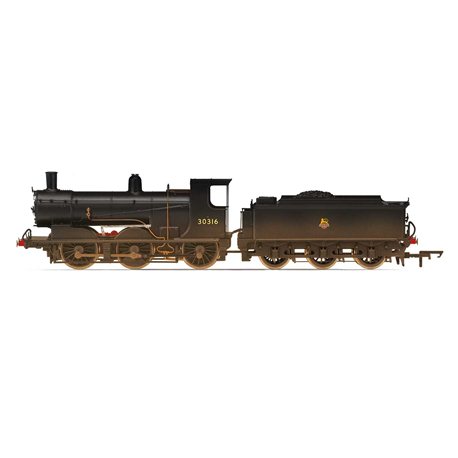No products
Product successfully added to your shopping cart
There are 0 items in your cart. There is 1 item in your cart.
Easter shipping
Please note that couriers are not collecting on Friday 18th and Monday 21st April.
Orders will be dispatched on Tuesday 22nd April
 View larger
View larger BR 0-6-0 700 Class - Early BR, Weathered
R3304
Hornby
BR 0-6-0 700 Class - Early BR, Weathered
- Length 190mm
- DCC Type DCC Ready
- Livery Early BR, Weathered
- Class 700
- Designer Dugald Drummond
- Entered Service 1897
- Detail Removable Coal Load and Diecast Boiler
- Motor 3 Pole Skew Wound
- Purpose Freight
- Wheel Configuration 0-6-0
- Special Features
- NEM Couplings
- Sprung Buffers
This product is out of stock
| Scale | OO (1/76) |
More info
BR 0-6-0 700 Class - Early BR, Weathered
- Length 190mm
- DCC Type DCC Ready
- Livery Early BR, Weathered
- Class 700
- Designer Dugald Drummond
- Entered Service 1897
- Detail Removable Coal Load and Diecast Boiler
- Motor 3 Pole Skew Wound
- Purpose Freight
- Wheel Configuration 0-6-0
- Special Features
- NEM Couplings
- Sprung Buffers
In 1895 it became apparent that the LSWR was in need of some 25 – 30 modern goods locomotives. At the time William Adams was still the locomotive superintendent of the London & South Western Railway but had to relinquish his position due to ill health in favour of Dugald Drummond.
Drummond whose past career had taken him from his native Scotland, to Australia and then to Glasgow brought with him not only a wealth of experience but designs of his own for the required 0-6-0 goods locomotive required for the LSWR. Drummond set about finding suitable manufacturers of the locomotive, eventually settling on Dubs & Co whose Works were based in Glasgow. Much of the locomotive’s design owed a great deal to the 0-6-0s produced for the Caledonian Railway and for which Dugald Drummond had been responsible.
Dubs & Co duly set about producing the required locomotives and from March to August, 1897 all 30 locomotives were delivered. The locomotives were numbered 687 – 716 when built however the locomotives were known as the 700 Class, however the official drawings also refer to them as “Dubs goods engines”! There were many components on this new Class that were already standard on several other LSWR locomotives, namely the C8 Class 4-4-0s, the K10 Class also a 4-4-0 and the M7 Class 0-4-4Ts.
There were initially some mechanical problems but one of the main concerns was the poor steaming. When built the engines were fitted with conical smokebox doors and firebox spark arresters and therefore to improve the steaming the arresters were removed and new Adams pattern smokebox doors were fitted between 1902 and 1904. After this the Class were used for rather unglamorous mainline freight duties, however during the First World War they were rostered for use on secondary passenger services as well as troop trains. They could also be seen frequently handling horsebox specials and for this locomotives 687 and 700 were equipped with Westinghouse air brakes, which were removed from both locomotives by early 1936.
During the First World War it became apparent that the 700s were under boilered and to this end Drummond’s successor, Robert Urie decided after the War to fit a superheater to locomotive No. 316. He also extended the smokebox and fitted a stovepipe chimney with a capuchin. Along with other changes to assist running, No. 316 emerged from Eastleigh Works in December 1920 and commenced running trials. The changes proved successful and Urie was authorised to superheat 10 others of the Class. These conversions took place between March 1922 and May 1924.
After Grouping in 1923, R. E. L. Maunsell who by then had superseded Urie arranged to have the remainder of the Class fitted with his own design of superheater, which had a slightly larger heating surface. These modifications took place between the years of 1925 and 1931 and those engines that had been superheated by Urie had their Eastleigh superheaters exchanged for the Maunsell variant between 1929 and 1933.
After these changes there were few alterations however some of the Class that ran on the Western section had chimneys fitted without capuchins.
The 700 Class engines were all initially coupled to a Drummond 3500 gallon six wheeled tenders with 13’ wheelbases, however in 1925 to 1926, 20 of the Class lost their tenders to the T9 and D15 4-4-0s which were used on the Eastern Section and the Waterloo-Portsmouth line. These 700s received as replacements used with the K10 and L11 4-4-0 locomotives, which had a 14’ wheelbase.
After this the class virtually remained intact well into Nationalisation but by the early 1960s the Class had all but disappeared with 30697 being the last of the Class to survive the scrap yard and was steamed for the last time in January 1964.
BR 700 Class, locomotive number 30316 was outshopped from Dubs & Co, Glasgow in August 1897. During BR days the locomotive was on Shed at 71A Eastleigh from where it was withdrawn in December 1962. In August 1963 locomotive 30316 was eventually cut up at the BR Eastleigh Works.
Suitable rolling stock: BR rolling stock of the period.

